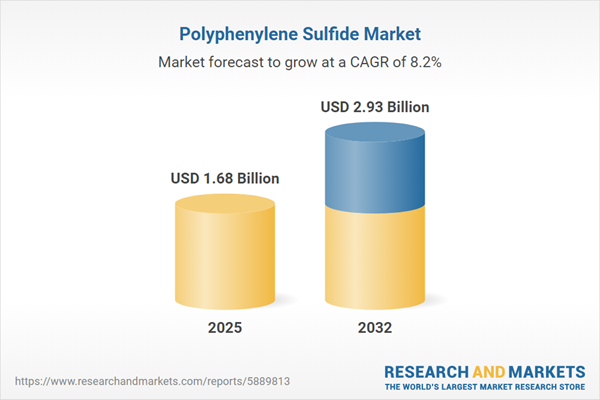Speak directly to the analyst to clarify any post sales queries you may have.
Polyphenylene sulfide is increasingly essential in advanced manufacturing, acting as a pivotal material in sectors that demand chemical resistance, dimensional stability, and thermal endurance. As regulatory and performance requirements intensify, the polyphenylene sulfide market continues to attract senior decision-makers seeking durability and scalable solutions.
Market Snapshot: Polyphenylene Sulfide Market Overview
The polyphenylene sulfide market has demonstrated steady expansion, backed by technological advancement and shifting industrial needs. The segment’s robust compound annual growth rate (CAGR) reflects a strong outlook. Market momentum is shaped by the growing use of this high-performance thermoplastic in demanding environments, as well as the rise of sustainability-driven procurement and material innovation among manufacturers.
Scope & Segmentation
This report delivers a comprehensive analysis of the polyphenylene sulfide market, segmented by end-use, grade, form, distribution channel, and region. Key areas examined include:
- Applications: Automotive, Consumer Goods, Electrical and Electronics, Industrial
- Grades: Glass Fiber Reinforced, Homo Polymer, Talc Filled
- Forms: Granule, Powder
- Distribution Channels: Direct, Distributor
- Regions: Americas (North America: United States, Canada, Mexico; Latin America: Brazil, Argentina, Chile, Colombia, Peru), Europe, Middle East & Africa (including United Kingdom, Germany, France, Russia, Italy, Spain, Netherlands, Sweden, Poland, Switzerland, United Arab Emirates, Saudi Arabia, Qatar, Turkey, Israel, South Africa, Nigeria, Egypt, Kenya), Asia-Pacific (China, India, Japan, Australia, South Korea, Indonesia, Thailand, Malaysia, Singapore, Taiwan)
- Leading Companies: Solvay S.A., DIC Corporation, BASF SE, Saudi Basic Industries Corporation, Toray Industries, Inc., Polyplastics Co., Ltd., Evonik Industries AG, Sumitomo Chemical Co., Ltd., LANXESS AG, Mitsubishi Chemical Corporation
Key Takeaways for Senior Decision-Makers
- Polyphenylene sulfide excels as a key solution in environments requiring sustained thermal and chemical stability, attracting attention from procurement specialists and material engineers across industries.
- Recent innovations in compounding and fiber-reinforcement have improved component reliability and supported deployment in next-generation applications, particularly in automotive powertrain, electrical insulation, and fluid handling.
- Sustainability imperatives are reshaping the competitive landscape, with leading suppliers advancing recycling initiatives and renewable energy integration at new and existing production sites.
- Regional differentiation is visible: North American and European markets emphasize compliance and localized innovation, while Asia-Pacific growth is fueled by high-volume manufacturing and automotive electrification.
- Collaborations among OEMs, material scientists, and regulators are driving new performance standards and driving the selection of polyphenylene sulfide in mission-critical designs.
Tariff Impact and Strategic Supply Chain Management
Recent United States tariff adjustments have prompted supply chain reconfiguration. Across the value chain, companies are diversifying intermediate sources and exploring domestic capacity expansion. Manufacturers, faced with rising import duties, have invested in regional facilities and design optimizations to stabilize cost structures. Procurement teams now focus on scenario planning and transparent modeling to anticipate policy-driven price volatility and to ensure continuous material supply.
Methodology & Data Sources
This report integrates primary stakeholder interviews, in-depth secondary research, and proprietary analytical frameworks. Engagements with material scientists, procurement executives, and product designers across core application segments provide direct insights. Cross-validation using industry literature, capacity databases, and regulatory filings ensures robust, actionable intelligence for market evaluation.
Why This Report Matters
- Equips procurement leaders and strategy teams with data-driven insights on supply chain risks, tariff exposure, and optimal sourcing models for polyphenylene sulfide.
- Clarifies evolving trends in technology adoption, sustainability, and regional investment, enabling executives to prioritize R&D or capital deployment with confidence.
- Benchmarks best practices among top-tier manufacturers, supporting peer comparisons and partnership evaluation.
Conclusion
Polyphenylene sulfide continues to rise in strategic value, fostering durable, compliant solutions in high-growth industries. Adept navigation of technology and supply shifts remains central for market leaders aiming to capture ongoing opportunity and mitigate emerging risks.
Additional Product Information:
- Purchase of this report includes 1 year online access with quarterly updates.
- This report can be updated on request. Please contact our Customer Experience team using the Ask a Question widget on our website.
Table of Contents
3. Executive Summary
4. Market Overview
7. Cumulative Impact of Artificial Intelligence 2025
Companies Mentioned
The companies profiled in this Polyphenylene Sulfide market report include:- Solvay S.A.
- DIC Corporation
- BASF SE
- Saudi Basic Industries Corporation
- Toray Industries, Inc.
- Polyplastics Co., Ltd.
- Evonik Industries AG
- Sumitomo Chemical Co., Ltd.
- LANXESS AG
- Mitsubishi Chemical Corporation
Table Information
| Report Attribute | Details |
|---|---|
| No. of Pages | 184 |
| Published | October 2025 |
| Forecast Period | 2025 - 2032 |
| Estimated Market Value ( USD | $ 1.68 Billion |
| Forecasted Market Value ( USD | $ 2.93 Billion |
| Compound Annual Growth Rate | 8.1% |
| Regions Covered | Global |
| No. of Companies Mentioned | 11 |









